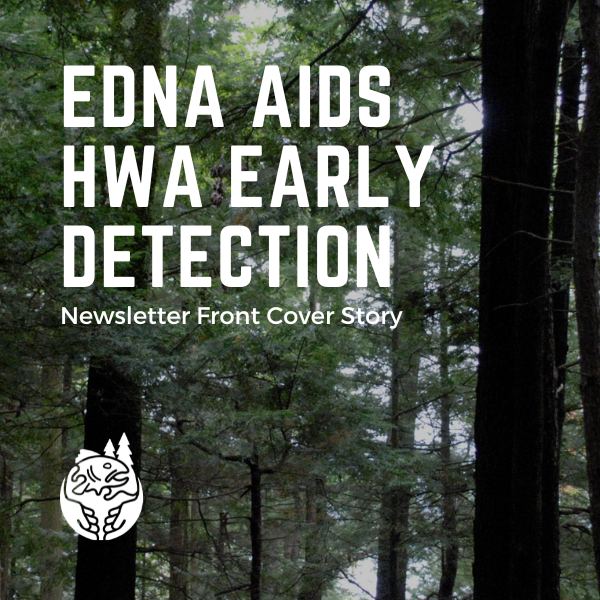This article was featured in the 2023 Spring Newsletter by, Tonya Bittner, Nicholas Dietschler, Mark Whitmore (NYSHI) & Zachary Simek (ADK & SLELO PRISM).
Early detection of hemlock woolly adelgid (HWA) can increase opportunities for management interventions that slow the insects’ spread and save hemlock stands. But how do we effectively detect an insect that is smaller than a sesame seed? The answer could be environmental DNA (eDNA).
Research led by the New York State Hemlock Initiative (NYSHI) at Cornell University suggests that eDNA is more sensitive than visual surveys when HWA is at low densities. NYSHI staff performed an early detection survey along the southeastern edge of Adirondack Park in the summer of 2022 in collaboration with Zack Simek from the Adirondack and SLELO PRISMs. Samples were collected from areas with known HWA infestation (three positive “controls”), no known infestation (five presumed negative “controls” >4 miles away), and by distance to closest known HWA (within 1, 2, 3, or 4-mile radius, n = 5 per category).
Laboratory analysis found HWA eDNA at 11 sites, including two “negative control” locations. There was no clear relationship between HWA presence and distance to the closest known infestation, but the results suggest the possible influence of prevailing winds (blowing northeast up the lake) on the dispersal of eDNA, or low and difficult-to-detect HWA densities. Trained volunteers from the Adirondack PRISM visited the new positive sites and did not find HWA during follow-up visual surveys, but new infestations can start with as few as one insect so continued survey is needed. This summer, the research team will resample all sites to evaluate whether eDNA signals disappear, increase, or stay the same.
We are excited to expand the HWA eDNA survey to the SLELO region in 2023. Following the sampling methodology piloted in the Adirondacks, PRISM staff will collect eDNA samples at various distances from known HWA along five transects (see map to right).
Samples will also be collected from approximately five locations greater than four miles from known HWA. These areas have already been visually surveyed by SLELO staff, providing an interesting opportunity to compare the effectiveness of visual and eDNA survey techniques.
All eDNA samples will be collected in June and we expect to share the survey results with partners this winter. These eDNA survey techniques show promise for sensitive assessment of large areas of remote forest along the expanding northern range of HWA. This tool fills a much-needed role, aiding traditional ground surveys in areas where hemlock can make up a large part of the forest community, allowing for early detection and a rapid management response.



